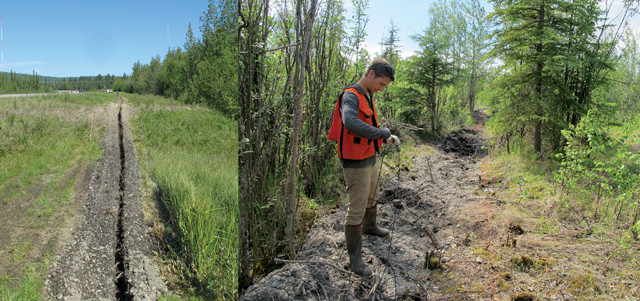
by Adityarup "Rup" Chakravorty Monday, March 19, 2018

Nathaniel Lindsey of the University of California, Berkeley, buries fiber-optic cable in a trench near Fairbanks, Alaska, to record earthquake seismicity. Credit: left: Anna Wagner; right: Nathaniel Lindsey.
Fiber-optic cables crisscross the world, ferrying digital data and enabling internet access and telecommunication. In a new study, published in Geophysical Research Letters, researchers tested whether fiber-optic cables can also be used to detect and measure earthquakes.
Using fiber-optic cables to monitor ground vibrations is not novel in itself; this method has been developed by the petroleum industry over the past decade. “But this study is one of the first to monitor earthquakes using existing telecommunications infrastructure,” says Robert Mellors, a seismologist at Lawrence Livermore National Laboratory in Livermore, Calif., who was not involved in the study. “It opens up a whole new potential for sensing earthquakes.”
Fiber-optic cables have some advantages over the seismometers most commonly used to monitor earthquakes today, says Nathaniel Lindsey, lead author of the new study and a graduate student at the University of California, Berkeley. “A seismometer sits on the earth at one location and records ground motion only at that point,” Lindsey says. “We are also limited in where we can install seismometers; for example, it is expensive and challenging to place seismometers in urban areas or far offshore.”
There are more than 160,000 kilometers of long-distance fiber-optic cables in the United States, but only part of this network is used for telecommunication; the unused portion, called “dark fiber,” is what researchers like Lindsey aim to use to detect earthquakes. “We can record the motion of a buried fiber-optic cable at essentially every point along it for tens of miles,” Lindsey says, which could allow this approach — called distributed acoustic sensing, or DAS — to yield high-resolution seismic data.
DAS involves connecting a laser “interrogator” unit to one end of a buried fiber-optic cable. The interrogator — about the size of a desktop computer tower — shoots laser light pulses into the cable and then monitors backscattered photons, the portions of that light reflected back toward the source from different points along the cable. Any stretching or bending of the cable, due to ground vibrations from a passing truck or an earthquake, for example, alters the path of the backscattered photons. By measuring these changes, researchers can piece together information about the strain on segments of the cable over time and quantify the speed and direction of the seismic waves responsible.
But fiber-optic cables used for telecommunication are rarely buried in direct contact with the ground. They are usually laid in conduits made of different materials, such as PVC piping coated with cement. So researchers weren’t sure if such cables would be sufficiently “coupled” to the ground to serve as reliable earthquake sensors.
To test decoupled cables, Lindsey and colleagues at Stanford University installed their own fiber-optic cable in an existing telecommunication conduit under Stanford’s campus. While monitoring this embedded fiber-optic cable, they detected several seismic events, including “nearby quarry blasts, small earthquakes within the Bay Area, and larger events from across North America,” the researchers wrote in the study.
How DAS measurements compare to those made with standard seismometers is still an open area of research.
Lindsey and colleagues at Lawrence Berkeley National Laboratory in Berkeley, Calif., compared data collected using fiber-optic cables and conventional seismometers in Fairbanks, Alaska, where they buried about 5 kilometers of cable over an area larger than two football fields directly into the ground.
There were several similarities in the data collected in Fairbanks using the two systems: For example, P and S waves from earthquakes were detected at the same time by both the coupled DAS array and standard seismometers. But there were also some differences. For instance, for seismic vibrations with frequencies lower than 1 Hertz and higher than 10 Hertz, DAS sensitivity falls off more steeply compared to conventional seismometers (broadband seismometers can reliably detect seismic motions with frequencies between 0.01 and 50 Hertz). In addition, data collected by the fiber-optic DAS can be “noisier and not include the quietest seismic signals,” Mellors notes.
“Using this technology, we may be able to convert the same fibers used for home [and] office internet into a huge seismic network that can help better detect and understand earthquakes,” says Zhongwen Zhan, a seismologist at Caltech, who was not involved with the study. However, “DAS only measures extension or compression along the length of a fiber, while seismic waves cause ground motion in three directions,” Zhan says. “So information from DAS alone is incomplete.”
Lindsey acknowledges that current DAS technology has its limitations. For example, “DAS isn’t measuring ground motion in all three dimensions,” he says. However, “having thousands of data points still provides much useful information.” Additionally, some researchers are looking at combining data from cables laid in various directions or configurations to mitigate the one-dimensionality problem.
Lindsey is now testing earthquake detection using existing dark fiber near Sacramento, Calif. “This experiment will be more reflective of how useful pre-existing fiber-optic cables can be in seismic monitoring,” he says.
© 2008-2021. All rights reserved. Any copying, redistribution or retransmission of any of the contents of this service without the expressed written permission of the American Geosciences Institute is expressly prohibited. Click here for all copyright requests.